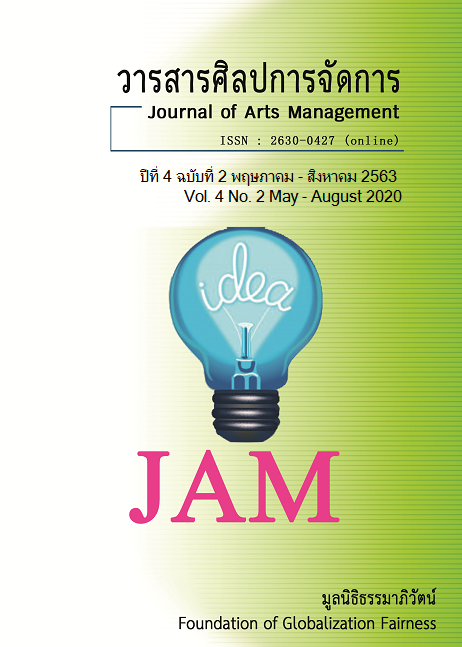The Influence of the Situation as an Entrepreneurship, Integration of Knowledge, and Innovation towards Performance of Community Enterprises in the Northern Region
Main Article Content
Abstract
The purposes of this research were to study the level of importance of entrepreneurship status, integration of knowledge, innovation and operational results, and to study the influence of entrepreneurship conditions that influence the integration of knowledge, innovation, and the performance of entrepreneurs of community enterprises by using questionnaires as a research tool. The sample group was community enterprise entrepreneurs in the upper northern region and evaluated at a good level for 206 community enterprises. Data analysis used descriptive statistics to analyze percentage, mean and standard deviation, and test the research hypothesis by analyzing the structural equations.
The results of the research showed that entrepreneurs with good assessment of community values emphasized entrepreneurship the most, with an average of 3.61, followed by innovation with an average of 3.71, for knowledge integration with an average of 3.73, and In terms of performance, there is an average of 3.61, with all aspects being at a high level. The hypothesis testing found that entrepreneurship influences the integration of knowledge and innovation including the integration of knowledge and innovation has a direct influence on performance, with the harmonization index of the model x2 = 77.90, df = 61, x2/ df = 1.27, GFI = .956, CFI = .990, RMR= .025, RMSEA = .037
Article Details
Views and opinions appearing in articles in the Journal of Arts of Management It is the responsibility of the author of the article. and does not constitute the view and responsibility of the editorial team I agree that the article is copyright of the Arts and Management Journal.
References
กษมาพร พวงประยงค์ และนพพร จันทรนำชู. (2556). แนวทางการพัฒนาวิสาหกิจชุมชนกลุ่มการแปรรูปและผลิตภัณฑ์ จังหวัดสมุทรสงคราม. วารสารศิลปากรศึกษาศาสตร์วิจัย, 5(1), 108-120.
กองส่งเสริมวิสาหกิจชุมชน. (2560). ฐานข้อมูลวิสาหกิจชุมชน. สืบค้นเมื่อ 2 พฤษภาคม 2562.
________. (2563). รายงานภาพรวมผลการประเมินศักยภาพวิสาหกิจชุมชน. สืบค้น เมื่อ 2 พฤษภาคม 2563. จาก http://www.sceb.doae.go.th/EVALUATION.html.
ชญาภัทร์ กี่อาริยโย, ธีรวุฒิ บุญยโสภณ, ทวีศักดิ์ รูปสิงห์ และวิเชียร เกตุสิงห์. (2559). รูปแบบ
การพัฒนาศักยภาพผู้ประกอบการวิสาหกิจชุมชนในกลุ่มจังหวัดภาคกลาง. วารสารวิชาการ พระจอมเกล้าพระนครเหนือ, 26(1), 141-152.
ธงพล พรหมสาขา ณ สกลนคร และอุทิศ สังขรัตน์. (2556). แนวทางการพัฒนาการดำเนินงานของ วิสาหกิจชุมชนในเขตลุ่มทะเลสาบสงขลา. สงขลา: มหาวิทยาลัยสงขลานครินทร์.
ธนาคารแห่งประเทศไทย. (2558). รายงานภาวะเศรษฐกิจไทย 2558. สืบค้นเมื่อวันที่ 5 พฤษภาคม2560. จาก https://www.bot.or.th/Thai/MonetaryPolicy/EconomicConditions/AnnualReport/ Pages/default.aspx
ธันยมัย เจียรกุล. (2557). ปัญหาและแนวทางการปรับตัวของ OTOP เพื่อพร้อมรับการเปิด AEC. วารสารนักบริหาร, 34(1), 177-191.
พิสิษฐ์ พจนจารุวิทย์. (2562). ประสิทธิภาพผลประกอบการของธุรกิจเกิดใหม่ Startup ในประเทศไทย. วารสารสมาคมนักวิจัย, 24(1), 99-111.
ยุทธชัย ฮารีบิน, สมนึก เอื้อจิระพงษ์พันธ์ และสุนันทา เสียงไทย. (2559). ความสามารถด้านเครือข่ายและความสามารถเชิงนวัตกรรมของวิสาหกิจขนาดกลางและขนาดย่อม. วารสารนักบริหาร, 36(2), 79-88.
สมบูรณ์ ขันธิโชติ และ ชัชสรัญ รอดยิ้ม. (2558). การพัฒนาศักยภาพด้านการตลาดกลุ่ม OTOP จังหวัด นนทบุรี : กรณีศึกษากลุ่มสมุนไพรที่ไม่ใช่อาหาร. วารสารวิจัยราชภัฏพระนคร สาขามนุษยศาสตร์และสังคมศาสตร์, 10(1), 125-135.
สหภาพ พ่อค้าทอง. (2557). การพัฒนาปัจจัยแวดล้อมในการเสริมสร้างศักยภาพการนำทุนวัฒนธรรมมาใช้เพื่อการสร้างแบรนด์ของผู้ประกอบการสินค้า OTOP ประเภทสินค้าศิลปหัตถกรรม. วิทยาการวิจัยและวิทยาการปัญญา, 12(1), 69-75.
Carland W.J., Hoy F., Boulton R.W. and Carland A.C.J. (1984). Differentiating entrepreneursfrom small business owners: A conceptualiz. Acdemy of Management Review, 9(2), 354-359.
Conner R.K. and Prahalad K.C. (1996). A Resource-Based Theory of the Firm: Knowledge versus Opportunism. Organization Science, 7(5), 477-501.
Cooper R.J. (1 9 9 8). A Multidimensional Approach to the Adoption of Innovation. Management Decision, 36(8), 493-502.
Drucker F.P. (1996). The Theory of the Business. Harvard Business Review. September-October, 95-104.
Gartner B W. (1988). Who is the entrepreneur? is the wrong question. American Journal of Small Business, 12, 11-32.
Grant M.R. (1996). Toward A Knowledge-Based Theory of The Firm. Strategic Management Journal. 17, pp.109-122.
Kim J. Y., Song S., Sambamurthy V. and Lee L. Y. (2012). Entrepreneurship, knowledge integration capability, and firm performance: An empirical study. Information Systems Frontiers. 14, pp.1047–1060.
Krejcie V. R. and Morgan. (1970). Determining Sample Size for Research Activities. Educational and Psychological Measurement,30, 607-610.
Lee C., Hallak R., Shruti R. and Sardeshmukh. (2016). Innovation, entrepreneurship, and restaurant performance: A higher-order structural model. Tourism Management. 53, 215-228.
Nieves J. and Haller S. (2014). Building dynamic capabilities through knowledge resources. Tourism Management, 40, 224-232.
Prahalad K.C. and Hamel G. (1990). The core competence of the corporation. Harvard Business Review, May-June, 79-90.
Rhodes J., Hung R., Lok P., Ya-Hui Lien B. and Wu C. M. (2008). Factors influencing organizational knowledge transfer: implication for corporate performance. Journal of Knowledge Management, 12(3), 84-100.
Schilling M. A. (2008). Strategic Management of Technological Innovation. (2nd ed.). New York: McGraw-Hill Education.
Schumpeter J. (1934). The Theory of Economic Development. Cambridge; Harvard University Press.
Sherman D.J., Berkowitz D., and Souder E.W. (2005). New Product Development Performance and the Interaction of Cross-Functional Integration and Knowledge Management. Journal of Product Innovation Management, 22, 399–411.
Sulistyo H. & Siyamtinah. (2016). Innovation capability of SMEs through entrepreneurship, marketing capability, relational capital and empowerment. Asia Pacific Management Review. 21, pp.196- 203.
Tabachnick B.G. and Fidell L.S. (2007). Using multivariate statistics. Boston: Pearson/Allyn & Bacon.
Tidd J. et al. (2001). Managing Innovation. New Jersey. John Wiley & Sons.
Thornhill S. (2006). Knowledge, innovation and firm performance in high- and low-technology regimes. Journal of Business Venturing, 21, 687– 703.
Utterback, J.M. (1994). Radical innovation and corporate regeneration. Research Technology Management, 37(4), 10.


